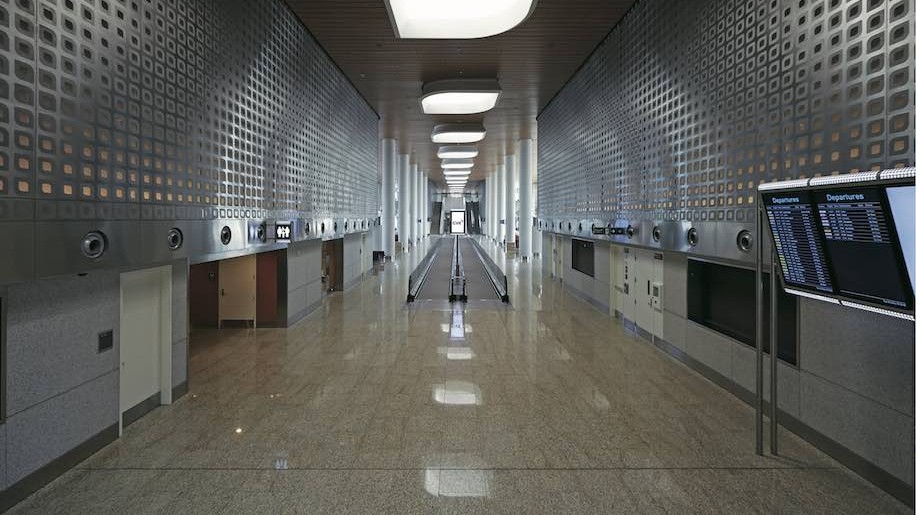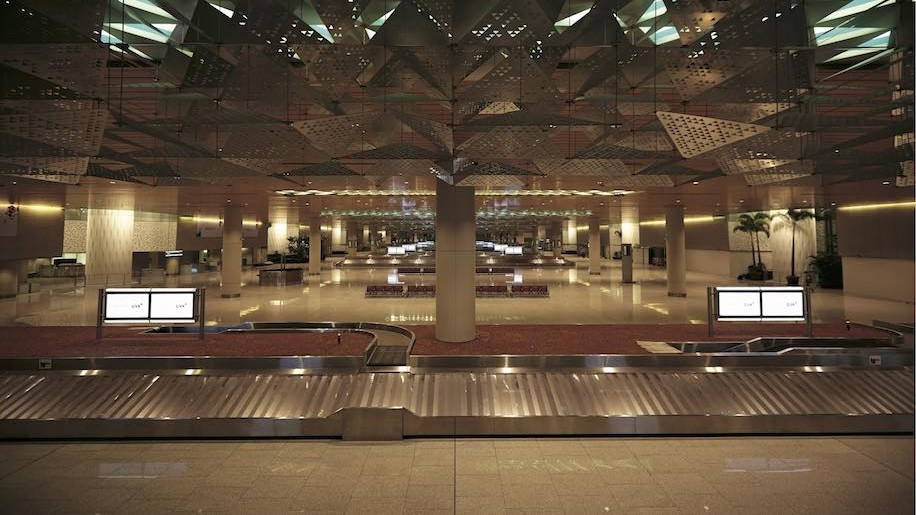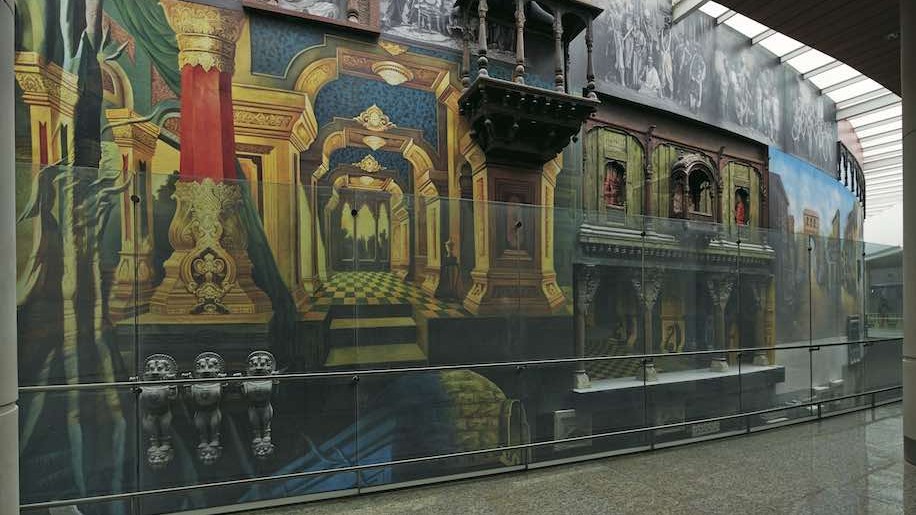
Up until 2013, Mumbai’s airport was never known for its customer service, let alone its aesthetics. When GVK, an Indian conglomerate began reconstructing the airport in 2009, the public’s expectations were modest. This was in spite of all efforts by GVK and the media to create a buzz around the new terminal.
It was only once Chhatrapati Shivaji International Airport Terminal 2 (CSIA T2) had officially launched in February 2014 that passengers were pleasantly surprised by its dramatic transformation. The interiors are inspired by Indian culture, and an example of this is the 3.2 km art wall titled Jaya He. The airport prides itself over this well curated collection, for it impressively speaks of ancient India.
A year since the launch of its reformed interiors and operations, T2 thus far has won a list of accolades to boast of. To name the most prominent, the airport is one of the reasons Mumbai won the “3rd Best Smart City” award in September, 2014 for its infrastructure, especially Jaya He. GVK CSIA has been conferred the award for “Outstanding Contribution in Airports – Infrastructure” category at the 5th EPC World Awards 2014. On October 29, 2014 it also won the Golden Peacock Award for Sustainability at the House of Lords at Westminster, London.
Its cable-stayed glass is the world’s longest at 15-metres and allows ample natural light, as do the 28 major skylights that are built using a combination of 272 pieces of glass of 55-square-metres each — the largest in Asia. In addition, there are 244 minor skylights of 140-square-metres each. If you look upward, the entire ceiling eludes the persona of a majestic white peacock.

Sanjay Reddy, Founder Chairman and Managing Director of GVK had one vision in mind while finalising the blueprints for CSAI T2 — if a person is blindfolded and brought to the airport, he should immediately be able to identify his location just from the surroundings.
All through the airport, there is a continuity of a peacock theme. Apart from this, the second most ubiquitous symbol is that of the lotus, as the national flower holds importance in Indian mythology and rituals. The most striking manifestation of these are the lotus shaped lanterns from its budding stage to full-bloom, all the way from security check to boarding.
In comparison to the other Indian airports, CSIA T2 has a limited 1400 acres allotted to it for expansion. This has led it to become India’s first multi-storeyed or “vertical passenger terminal” as the airport terms itself. On an average day, the terminal can comfortably manage a movement of about 200 international flights, 500 domestic flights and 9500 passengers; and it handles 19 per cent of the country’s air passenger traffic.
There are 188 check-in counters for economy class passengers and an additional 20 counters reserved for business and first class passengers. These are designed such that they mirror a typical Indian shamiana or marquee. The only difference between the two counter types is that the latter offers sofas and coffee tables as well.

Peak hours can seem chaotic in terms of winding queues and overcrowded counters. In such cases, the ground staff often encourages passengers to check-in through any of the electronic kiosks and then line up to drop off luggage at a separate counter. This may help, if only marginally, for the traffic is simply diverted. In such instances, the conspicuously positioned information desks are a welcome feature for flyers in doubt.
Post check-in, there are 43 security pedestals, and unlike other airports, T2’s immigration counters are built after security clearance. This gives passengers a chance to send back prohibited items if any, such as liquids above the permitted amount and medication without prescription, with waiting relatives at see-off.
Right behind the security check is the immigration area. Lines can move quickly here and this is probably because of the 60 immigration desks. A smooth flow leads into a 21,000-square-metre sprawl of retail space with luxury and local duty- free shops, spas, restaurants and cafés. For whiskey enthusiasts, it is here that you will find the world’s fourth Johnnie Walker House — the others are in Shanghai, Bejeing and Seoul.
For those who would rather just relax, a lounge for business class passengers on level 3 (capacity: 260) and first class passengers on level 4 (capacity: 170) pampers guests with spa treatments, showers, sleeping cots, a well-equipped bar and a library. This is common to passengers of all airlines, a feature more typical of regional airports. The downside of this is that it robs flyers of some privileges that may be exclusive to certain airlines.

Again, for members of a loyalty programme, the common Loyalty Lounge or Clipper Lounge on level 3 is convenient with hi-speed internet, work stations, laptop and mobile phone charging areas, and cabanas for a quick snooze.
GVK has its own lounge too — Pranaam Lounge — a service which is offered at a premium price to passengers flying international and domestic routes, and across all classes. Once booked online (csia.in), they escort you right from check-in to the lounge and finally to boarding.
Up until January 9, 2015, T2 had only international flights flying out of here. Air Vistara was the first domestic airline to operate out of this terminal. The check-in area is shared with international flyers, but the security procedure and gates are down a separate route. In future, the airport hopes to cater to more domestic passengers. Hopefully these queues won’t add to the peak hour traffic. The airport claims to already have the necessary infrastructure in place to manage that kind of flow though. Apart from better managed check-in counters, all 52 landing bridges man two gates each and can handle arriving and departing flights at a time.
Passengers in transit, find it easy to transfer from the international to domestic terminal and vice-versa. Bold signs direct you to
the 24-hour transport facility from where air- conditioned coaches with a capacity of 40 to 44 passengers depart every 20-30 minutes to and from the domestic and international terminals.
Despite being a small airport, it is still a trek for international passengers arriving in the city. GVK has done what it can do to make this less tiresome — carpeting for a cosy feel, artworks that are easy on the eye, and fountains that dot the walkway from the gates to immigration. Sanjay Reddy believes that both, the sight and sound of water is a soothing element, and has built several fountains in the arrival area for the benefit of fatigued flyers. The artwork distracts you from the race to immigration with Mumbai’s changing landscapes, and dynamics. A first time visitor is promised a taste of the city even before exiting the airport.
Again, 76 arrival immigration counters speed up the process. For security reasons, the government insists you once again show your boarding pass and passport to a guard right after, and before he lets you into the duty-free and baggage claim area. This is more likely to create a bottle-neck in the exiting process.
With 10 baggage carousels that can handle 9,600 bags per hour, your luggage arrives within a decent timeframe. Be prepared for a probable bottle-neck again during the mandatory baggage screening at Customs.
On the whole, CSIA is a pleasant experience for passengers, for its blueprints have been sensitive to the travellers’ needs from inception. Being the first visually appealing airport in India, its launch has set new benchmarks for others in the country.

CSIA T2 FACILITIES
Valet at departure
Free Wi-Fi
Prayer/meditation room
Postal services
ATM facilities
Cafes at arrival for waiting guests
Inter-terminal coaches at no cost n Taxi booking through the website (csia.in)
CSIA IN NUMBERS
2 crossed runways
40 million passenger-capacity n 40 domestic cities connected through direct flights
43 take-off and landings per hour n 43 flight connections per day
52 passenger boarding bridges n 5000-capacity car park
WORK IN PROGRESS
Airport Hotel for passengers in transit and GVK Museum to encourage traditional Indian artists
STAR ALLIANCE MEMBERS
Air India
Air China
EgyptAir
Ethiopian Airlines
Lufthansa Airlines
All Nippon Airways
Singapore Airlines
South African Airways
Swiss International Airlines n Thai Airways
Turkish Airlines n United Airlines
ONE WORLD ALLIANCE MEMBERS
British Airways n Cathay Pacific
Malaysia Airlines n Qatar Airways
SriLankan Airlines
SKYTEAM ALLIANCE MEMBERS
Air France
Delta Air Lines n Kenya Airways n Korean Air
Saudia Airlines











